VOCALIZE: A Natural and Cultural History Project
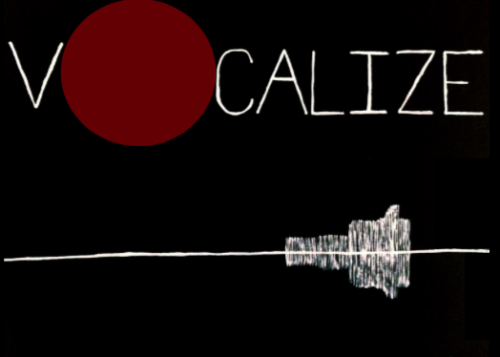
By Emily Ford, graduate student in the Institute’s 15th cohort.
“VOCALIZE” attempts to share the Natural and Cultural History of the Loon through multiple ways of knowing. This project blends Indigenous Education and Scientific Study through the following list of topics, in order to create an ecological and social learning platform for all: Etymology, Art, History, Biography, Archeology, Astronomy, Taxonomy, Phylogeny, Poetry, Geology, Mapping, Natural History, Anthropology, Biology, American Literature, Conservation Studies, Storytelling, Indigenous Education and Pedagogy, and Place-Based Learning.
The multidisciplinary nature of Natural History allows both cultural and scientific knowing to be shared and valued. The Common Loon (Gavia immer), is not only the focus in this project, but also provides a lens to investigate Environmental and Social Justice, especially as it pertains to North America’s Native First Peoples. The Loon’s hauntingly visceral “call of the wild” has spoken to humans throughout the centuries, and offers a vessel for silenced cultural perspectives to come to light.
Within the project booklet, you will learn about the appearance, habits, and vocalizations of the charismatic Common Loon. Dive beneath the water, and you will also experience the emotions, voices, stories, and values held by the Loon. As we observe and interpret the Loon’s being, we must also recognize the human context of engaging with nature. “VOCALIZE” serves as an example and call to action for all readers to be open minded, aware, and inclusive of diverse human experience and beliefs.
It demonstrates the importance of listening to and valuing every voice, including the voice of the Earth, as we come to realize our interrelations.
For example, I examine the word “vocalize,” often used to describe the loon’s various calls. In English, “Vocalize” means to articulate, or to sing vowel sounds, and comes from the root ‘call out’, or ‘cry.’ I pair this with the many Ojibwe definitions, in order to value their language and roots of their words. This serves as an example of how language is a form of power, and it is important to present more than just one perspective. I also use this word to reiterate the layered metaphors of indigenous oppression throughout the project. A loon’s call in the night comes out of the silence, and echoes with a wounded mournfulness, yet stands strong in people’s memory of wilderness and beauty. Paired with these concepts, I also include scientific studies of the four loon calls and their adaptive uses for communication.
Similarly, I investigate the bird’s many names. Loon’s scientific name is Gavia immer, from Scandinavian roots. In Ojibwe, “Loon” and “brave” are the same word: “Maang.” I then share the creation story of the loon, from astronomy, to Indigenous creation stories, to evolution and archeology.
My poetry is scattered throughout the booklet to reinforce the subject topics and include my own reflections and voice. This poem follows the investigation of our naming of the loon and its vocalizations, as well as a discussion of layered metaphors about the power and oppression of language use. Accompanying the poem is art by Ojibwe artist Jackson Beardy who fought as an activist, educator, and artist, for the rights of Canada’s First Peoples and the revitalization of woodland cultures.
VOCALIZE
lake night, ink-black stillness
unnamed, you could be anywhere
out of the infinite silence
suddenly
Loon’s wail,
piercing the vacuum
mournful, growing,
searching harmonics:
“where
are
you? ”
the echos patiently ripple
until settling acoustics
soften the abyss
back into warm darkness
full but silent
like your heart
the red moon pulses
beyond a cloud cage
you inhale, the void
tightening inside you.
bursting with bravery,
Solidarity,
You respond.
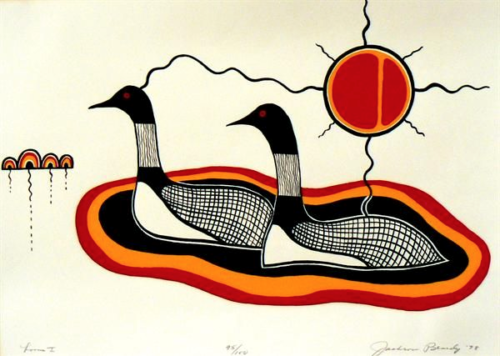
Jackson Beardy, Bear Claw Gallery – First Nations Art
Another example of my multi-disciplinary and multi-perspective Natural History investigation is the shared theme of diving, and going beneath the surface.
Slide One: Adaptations
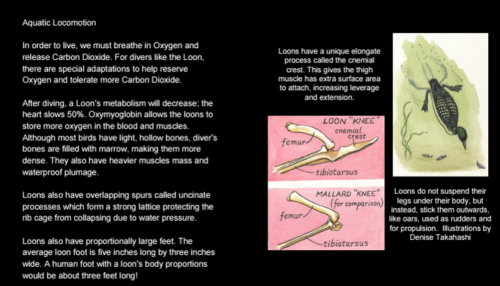
Slide Two: Ojibwe Loon Clan System
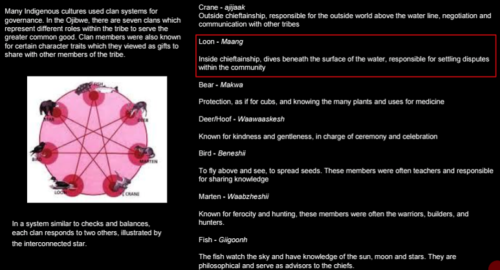
Slide Three: Artist and Biography (Bear Claw Gallery)
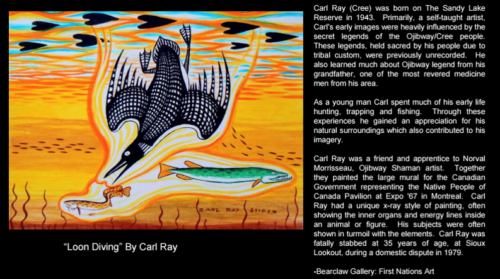
Lastly is a poem written in context of a discussion of wilderness, wildness, conservation, and my personal journey during this loon project. Part of my project was reflecting on my personal experiences with loons, growing up in Northern Michigan and spending childhood summers in Killarney, Ontario and upstate New York. Loons in North Cascades National Park are uncommon but present, and I have heard and observed a few during my year here. On the last morning of our 2015 wildfire evacuation, I heard a loon wail across the lake, stilled by smoke-saturated air. This spring, I got to know two loons on Diablo Lake and saw over 70 Pacific Loons in their breeding plumage migrating North on the Salish Sea. Lastly, I hope to join the park survey to revisit a breeding pair at Hozomeen Lake this summer.
Spring Wind
I hear Loon call
From the distant lake
Through my closed doors
Like a skipped stone
The mournful wail
taps open the still water,
once
dense
with discontent
broken by drumming over the depths now brimming
with vibrant concentric rings rippling
and a persistent pulse to shore radiating
up
through Cedar’s spine,
who sways grounded
grounded in gratitude for roots, rings,
and a view framed by supple needles,
needles like the end of a conductor’s flowing baton,
which softly invite the first collective inhale
then breathe the first note of music into the air
the spring wind whispers awake
sweeping clean the meandering, deserted crevasse
which somehow held empty space full
with heart-wrenched winter wishing
And the spring wind whistles along
beaded by floating, twirling pollen
tousling long hair and
tickling the nose of a well-rested black bear.
After a couple of twitches and scrunches,
he blinks his obsidian eyes, and rises from slumber
and the spring wind sings stories
across forests of bird song
from those who have arrived, and those yet to come
sailing in on the swells of warm rain
and the sweetness of first flowers
And the spring wind howls harmonies
with coyote’s playful yips,
summoning one frog’s sluggish croak
into a cacophony of choppy waves
It swirls around Cedar’s crown,
and dances back into its boughs,
nesting in comfort and heartbeat
Saturated,
it spins into spider’s web woven,
tangled with life as we know it
wrapped at last
in warm, silky embrace
before scattering silently to the stars.
Thank you for reading and if you have any questions, or comments, feel free to email me at emily_ford@ncascades.org.

